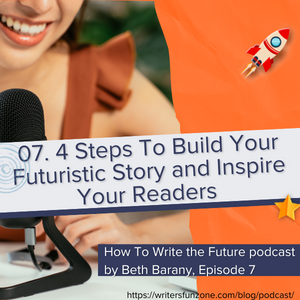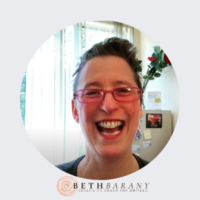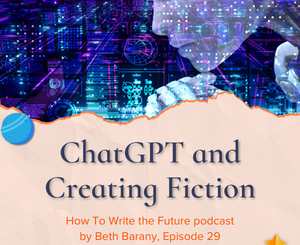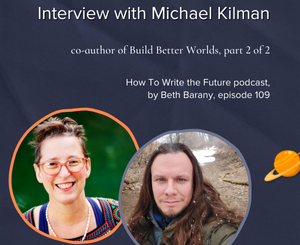4 Steps to Build Your Futurist Story and Inspire Your Readers
“From Conventional to Wow: 4 Steps to Build Your Futuristic Story and Inspire Your Readers” where I invite you to step out of your comfort zone in many different ways to help benefit your future writing.
Have a listen to the latest episode here: Apple Podcasts | Google Podcasts | Spotify | Buzzsprout | Amazon Music | Podcast Addict | Listen Notes| Youtube
ABOUT BETH BARANY

Beth Barany is an Award-winning Novelist, master neurolinguistic programming practitioner, and certified creativity coach for writers, including being a Workshop Leader & Keynote Speaker. Beth has published books in several genres including young adult fantasy, paranormal romance and science fiction.
Learn more about Beth Barany at these sites: Author site / Coaching site / School of Fiction / Writer’s Fun Zone blog
RESOURCES
- Craft Compelling Characters course: https://school.bethbarany.com/p/compelling-characters
- Amy Webb, The Signals Are Talking: https://books2read.com/thesignalsaretalkingwebb ; and her organization: Future Today Institute: https://futuretodayinstitute.com/
- School of International Futures: https://soif.org.uk/
- STEEP (a few resources out of many)
SHOW NOTES
“This process does require you to be adventurous, to dare, to come from a risky place. Stretch a little bit to attempt to blow the minds of your readers.”
In today’s podcast episode titled “4 Steps to Future Build Your Story and Inspire Your Readers,” Beth invites you to step out of your comfort zone and shares ways you can do to nourish your creative mind and work.
In this episode you will:
- Identify new methods to inspire future writing ideas.
- Discover how you can incorporate the acronym STEEP+V into your Science Fiction writing.
- Learn how to create positive futures to excite readers.
Connect with me
Email: Beth@bethbarany.com
Loved this episode? Leave us a review and rating here: https://www.buzzsprout.com/2012061
ABOUT THE HOW TO WRITE THE FUTURE PODCAST
Beth Barany runs the How To Write The Future podcast for science fiction writers who want to write positive futures and bring those stories successfully out into the marketplace.
Tips for fiction writers!
This podcast is for you if you have questions like:
- How do I create a believable world for my science fiction story?
- How do figure what’s not working if my story feels flat?
- How do I make my story more interesting and alive?
This podcast is for readers too if you’re at all curious about the future of humanity.
TRANSCRIPT for 07. 4 Steps to Build Your Futurist Story and Inspire Your Readers
Steps to Build Your Futurist Story and Inspire Your Readers
Recently, a friend and fellow writing teacher came to me and told me how her students were turning out stories set in the future that seemed conventional that seemed kind of blah. And she wondered how she could help them. So, I came up with a bunch of ideas and I realized this is perfect for this episode.
Because in this episode, I’m going to share with you four steps to help you make your future story, your futuristic story, from conventional to wow.
We’re talking about the kinds of stories where you want to build a positive future, and imagine things way better than they are now, not in typical ways, in unusual ways.
Hi everyone. I’m Beth Barany. I am a novelist, writing teacher, and host of this podcast, How To Write The Future. Welcome to Episode 7.
Today we will cover four steps on how you can build your story and inspire your readers.
This podcast is for science fiction writers who want to write positive futures because when we envision what is possible, we help make it so. Also this podcast is for writers who want to succeed on their own terms in the marketplace.
As I said in the opening, my friend came to me with this challenge that she was experiencing. Her students, granted they’re young, 18, 19 years old. They were writing conventional stories about the future. Drawing from their own lives probably and, what I imagine is probably scenarios that looked a lot like today.
They weren’t imaginative enough. They didn’t pop. They didn’t stretch as writers.
So in today’s episode, let’s dive in to these four steps. But first, I want to say that of course, there are so many ways to go about addressing this issue, so many ways, and my way, it’s just what came up for me, and if I were teaching the class, I would probably go about it in this kind of way.
I do want to say that this process does require you to be adventurous, to dare, to come from a risky place. Just stretch a little bit to attempt to blow the minds of your readers.
So, for this approach to work, I am really encouraging you to step outside your comfort zone, even just a few inches, or feet, or yards, or meters. And it isn’t a really a one-time thing.
It’s really, how can you do this every day, as a creative writer? How can you stretch outside your comfort zone a little bit every day?
This is how you bring in new ideas. This is how you nourish the creative mind and heart and soul.
So very simply put, you want to pursue a steady diet of new ideas, new stories, new people, new places, new things, new music, new routes to and from, new exercise routines; actively learn a few new words every day. Actively ask Why and How to anything you don’t understand.
I encourage you to research worldviews and mind maps that are similar to yours, but not the same, and also, opposite yours, 180 degrees opposite. Be open, be curious. Pull from the fringes of the fields that you are interested in.
If you want some more on that, go listen to the episode that I did on the signals are talking, which has inspired by the book by the same name, The Signals Are Talking by Amy Webb, episode six. You could see a link in the resources.
This is a given. Step outside your comfort zone a little bit every day. Pick one thing every day to stretch yourself a little bit.
Here’s my four steps in a step-by-step order.
What I just offered to you is more like a laundry list that will help you in all your creative work. But now let’s go about it in a more step-by-step manner.
So Number One is: give yourself a steady diet of at least one new thing from the list I just gave you every day. You may need to do this for a week or so before you start to notice that your perception of reality is starting to shift.
I do this actively. In fact, nearly every morning while I have my breakfast of coffee and a hard boiled egg and some cheese, or, or maybe it’s oatmeal today or scrambled eggs — it varies, but always the coffee — I pick one video to watch on YouTube, or read one article. So, as part of my breakfast, not only am I bringing in my body nourishment, but I am also bringing in my mind and creative space nourishment.
One example of this is universal basic income. I have been interested in this topic for a really long time. So, I have steadily been reading articles and watching videos on the topic. This came into my story series, Janey McCallister Mystery series, where in her backstory, she’shaving lived in a universal basic income zone.
But I wasn’t able to really write about it until I had done research, and the research didn’t happen in one afternoon. It happened over a period of months because I’m always bringing in new information to help me with future stories. All right.
So Number One is input a steady diet of at least one new thing every day to stretch your awareness of what exists in reality.
Number Two: When you think about your story and what your story could be, I invite you to start with this question: What do you wish was different in today’s world than the way it is?
What do you wish was different in today’s world than the way it currently is?
Then escalate it or twist it by asking what is more outlandish or bizarre or newer than that?
Brainstorm 10 to 20 different things that it could be. More outlandish or newer. Or more fun or more the way you want it. Stretch your mind by brainstorming. Try to get to 20 possibilities.
Another way to look at this– if you want to zoom in on, how do you focus what you wish was different?– here is an acronym that I learned at the School of International Futures retreat that I was on the summer: use the acronym STEEP.
That’s S T E E P.
It’s an acronym – -for S Social for S; T Technological; E Economical; E Environmental;. And P Political. Now we briefly mentioned at the retreat another letter to add, and that is V, V like Victor. And that stands for Values.
If you could look at what the world is like today through these six lenses: Social, Technological, Economical, Environmental, and Political and Values. Pick one, and that is where you going to focus what you wish was different.
Here’s one example. I would say this is maybe Environmental and Economical at the same time.
So, I dreamt up a highly customizable environment that traveled with the customers in this very fancy hotel that is the setting for the first four books in the Janey McCallister space station Mystery series.
If you book a room at this hotel, which is very expensive, it’s a high-end hotel, then when you walk through the corridors to, and from your room, your favorite smells and your favorite music travel with you. It’s because I made the walls highly customized and able to pick up this information and the building, it’s like smart building times a thousand.
So that they, the whole experience in their room and in the hallways was delightful. And then there are some environments that are completely built to be Settings. Like the lobby is a Mediterranean setting. And then when they get to the casino, it’s a casino with amazing, amazing setting that is built to wow people and get them excited to gamble.
So that’s how I took this notion of: What if the environment was highly, especially tailored to you?
The Economic piece is you pay for that experience. You pay for the highly tailored, customized experience of having your environment tailored to you. And I put that into the hotel.
So Number One: Stretch.
Number Two: Story plan by asking, what do you wish was different, and brainstorm.
Number Three: Your Main Character. Who does your main character need to be for this change to be an everyday occurrence for them? How do they view it? How do they experience it? How do other characters in your story also view and experience it? Is it positive? Is it negative?
In my stories, my main character, Janey McCallister, experiences this particular change in the hotel with amusement, but she is not highly aeffected by it because she’s staff. So for her, it doesn’t really affect her, but then there are instances where she gets to experience the lovely experience for the customers, and that is something she enjoys.
[00:10:06] If you want more help with character development and character design, I have a course in my school. There’s a link in the show notes to my craft Compelling Characters course.
Now there’s a fourth point. If this desire that you have, this change were normal in your Story world, what problems does that create for the characters in your world? Even for your main character or other characters. What are the unintended consequences? For whom could this change be detrimental or even harmful?
And also connect this change somehow to your character, to the problem of your story.
The issue inside of my story that colors the setting of the story is actually not a direct problem for my main character. But there are some other problems caused by the setting that I play with throughout the story.
So I didn’t make a huge deal about it in this story. It’s just, it’s a built into the environment. But in my story that I’m working on, I have an environment that is going to have some unintended consequences for Janey and other people. No spoilers yet. Still working on Book Five.
So in conclusion, in conclusion, if you want to go from ordinary to wow in your stories, you need to input new ideas regularly so that you can create stories that dynamically explore these positive futures you want to create in a way that surprises your reader and also excites you as the author.
You want a steady diet of new ideas– Number One.
Number Two — you want to ask yourself, what do you wish was different than the way it is, and then escalate that and find the real wow factor. You can use the STEEP+V acronym as a guide to focus you.
Steep is Social, Technological, Economical, Environmental, and Political. Then I added V for Values.
Then you want to step into your main character and ask who does he or she, or they need to be for this change to be felt as real?.
And then Number Four, you want to think about the unintended consequences or problems this normal thing in your world causes for your characters in it, including your main character.
That’s it for now.
Stay tuned for the next episode.
Follow me on the socials specifically, Twitter and LinkedIn. Or write me if you have any questions.
Signing off for now.
Write long and prosper.
Loved this episode? Leave us a review and rating here: https://www.buzzsprout.com/2012061
or in your podcast home of choice.
***
CREDITS
EDITED WITH DESCRIPT
https://www.descript.com?lmref=_w1WCA (referral code)
MUSIC CREDITS
Music from Uppbeat (free for Creators!): https://uppbeat.io/t/soundroll/fuzz-buzz
License code: UMMKDRL02DFGKJ0L. “Fuzz buzz” by Soundroll.
Commercial license: https://musicvine.com/track/soundroll/fuzz-buzz
Distributed by Buzzsprout: https://www.buzzsprout.com/?referrer_id=1994465 (referral code)
SHOW PRODUCTION BY Beth Barany
SHOW NOTES SUPPORT from Kerry-Ann McDade
***
For more “How To Write the Future” episodes, go here.
If you’d like to invite Beth onto your podcast, drop her a note here.





